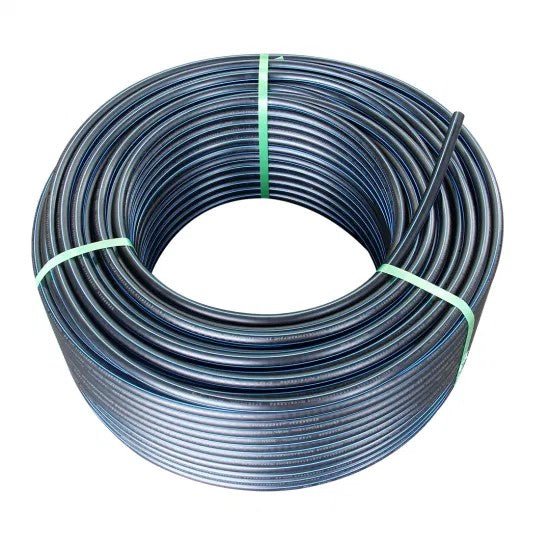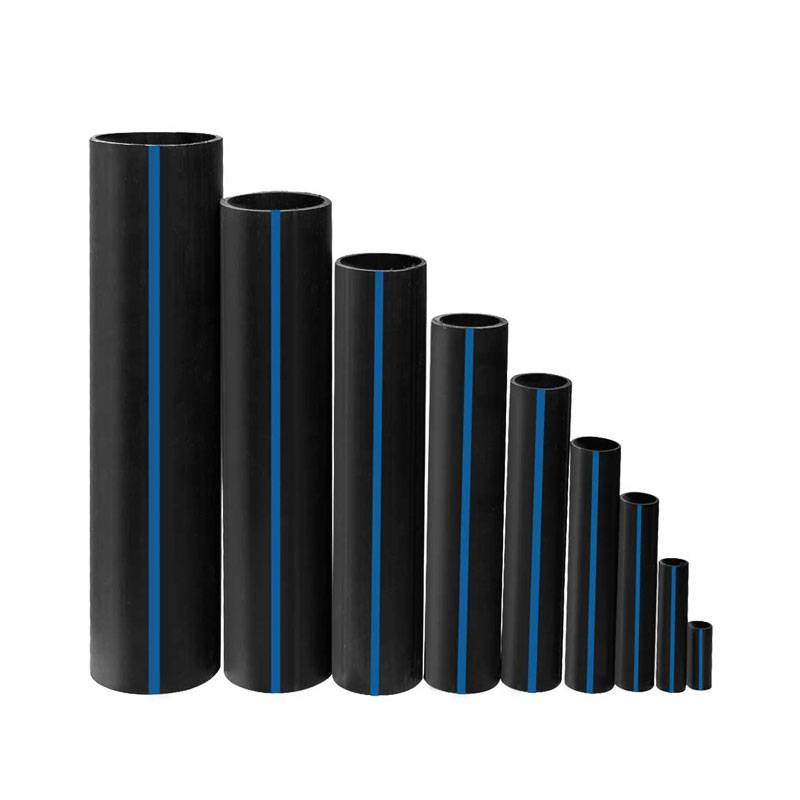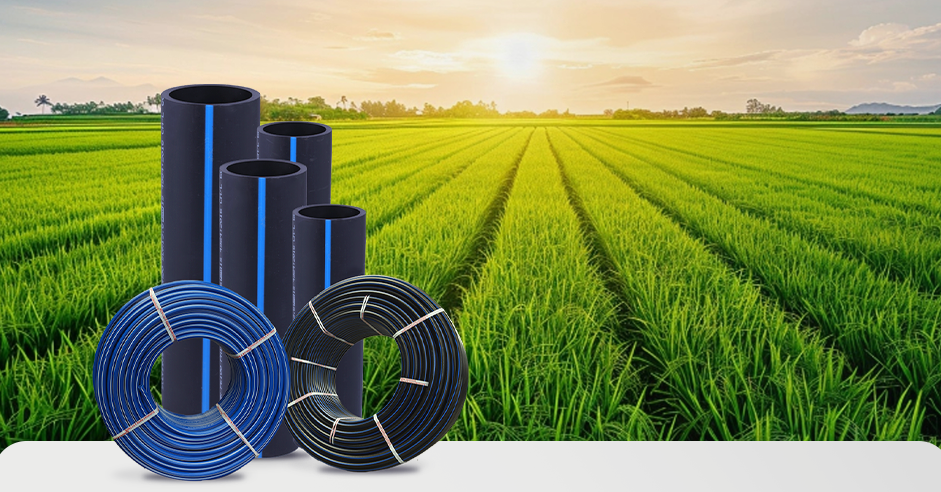Texas hdpe pipe manufacturer: Green Manufacturing
Check Out the Manufacturing Refine Behind High-Quality HDPE Pipeline and Its Applications
The production procedure of top notch HDPE pipelines is elaborate and methodical. It starts with the selection of resources that enhance performance. Following this, ethylene undertakes polymerization to form resin, which is then shaped via extrusion. Quality assurance is extremely important, making sure that the last item satisfies rigid requirements. However, the trip of HDPE pipelines does not finish with production. Their applications throughout numerous industries reveal a more comprehensive relevance worth examining.
Recognizing HDPE: Qualities and Advantages

High-density polyethylene (HDPE) is a functional polycarbonate recognized for its sturdiness and resistance to various environmental elements. This product shows excellent tensile toughness, making it suitable for demanding applications. Its low-density framework contributes to a light-weight item, promoting convenience of taking care of and setup. HDPE also showcases remarkable resistance to chemicals, which decreases deterioration when subjected to rough materials.
The product's reduced moisture absorption further enhances its long life, making it ideal for usage in pipes and tank. Additionally, HDPE is resistant to ultraviolet (UV) radiation, ensuring that items maintain their honesty also when revealed to sunlight. In addition, its versatility enables the development of intricate forms without jeopardizing stamina. The green nature of HDPE, typically acquired from recycled materials, contributes to its charm, promoting sustainable practices in production. On the whole, these residential properties and benefits make HDPE a favored selection for numerous industrial and consumer applications.
Raw Product Option for HDPE Manufacturing
The option of basic materials for HDPE production is necessary to validate the last product satisfies the preferred specs and top quality requirements. High-density polyethylene (HDPE) is mostly created from polymerized ethylene, stemmed from fossil gas such as all-natural gas or petroleum. The quality of these feedstocks greatly affects the mechanical and thermal homes of the last HDPE.
Additives also play a significant function in boosting HDPE's performance, including anti-oxidants, UV stabilizers, and colorants, which enhance durability and resistance to ecological aspects. The choice procedure must think about not just the chemical make-up of the raw products but likewise their handling characteristics to guarantee effective manufacturing.
Moreover, the sourcing of resources need to prioritize sustainability and compliance with environmental laws, as accountable techniques are necessary in today's market. Ultimately, mindful raw material choice lays the foundation for producing top quality HDPE pipelines appropriate for varied applications.
The Extrusion Refine: Shaping HDPE Pipeline
The extrusion process plays an important role in forming HDPE pipes, beginning with careful product prep work strategies that assure excellent circulation and uniformity. Equally vital is the style of the die, which directly affects the final dimensions and surface area high quality of the pipe. Together, these variables contribute greatly to the performance and high quality of HDPE pipe production.
Material Preparation Techniques
Effective production of HDPE pipes starts with meticulous material preparation strategies, specifically the extrusion process. During this stage, high-density polyethylene material is very first dried out to remove moisture, ensuring optimal circulation characteristics. The resin is after that fed into the extruder, where it undertakes heating and melting, transforming right into a viscous state. This home heating process is meticulously managed to preserve the material's honesty and efficiency. The liquified HDPE is compelled with a die, forming it into a continuous pipeline kind. Appropriate temperature administration throughout extrusion is essential, as it directly affects the material's residential properties and the end product quality. As soon as shaped, the HDPE pipeline is cooled and reduced to specified sizes, prepared for subsequent processing and applications.
Die Style Significance
Accuracy in die style plays a crucial function in the extrusion procedure of HDPE pipelines. The die functions as the final shaping tool, straight influencing the pipe's measurements, wall density, and surface finish. A well-designed die warranties consistent product flow, lowering flaws such as irregularities and vulnerable points. The geometry of the die have to be maximized to fit the certain properties of HDPE, including its thickness and thermal habits throughout extrusion. Additionally, the cooling rate of the product as it passes through the die can markedly influence the pipeline's structural honesty. Consequently, buying sophisticated die innovation is vital for makers aiming to produce top quality HDPE pipelines that meet sector requirements and customer expectations.
Quality Assurance Procedures in HDPE Production
Numerous factors affect the high quality of HDPE pipe manufacturing, reliable high quality control procedures are crucial to ensure uniformity and integrity in the last item (hdpe pipe fittings Midland TX). Secret quality control methods include extensive product assessment, validating that the raw polyethylene meets have a peek here well-known criteria for pureness and thickness. Throughout the extrusion process, specifications such as temperature level, pressure, and cooling time are closely monitored to keep dimensional accuracy and structural stability
On top of that, post-production screening is important; suppliers usually conduct hydrostatic examinations to evaluate the pipeline's toughness and resistance to pressure. Visual assessments for surface defects further improve top quality assurance. Certification from relevant criteria organizations, like ASTM or ISO, supplies an additional layer of credibility. By carrying out these thorough quality assurance procedures, producers can decrease issues, boost performance, and make sure that the HDPE pipes fulfill the certain needs of different applications, eventually leading to customer satisfaction and depend on in the item.
Applications of HDPE Pipe Throughout Industries
HDPE pipes are used across numerous sectors due to their toughness and convenience. In water distribution systems, they guarantee reliable shipment, while in wastewater administration, they provide reliable remedies for waste transport. In addition, agricultural irrigation networks benefit from HDPE's resistance to deterioration and adaptability, making it a perfect option for contemporary farming practices.

Water Circulation Equipments
A considerable number of industries rely upon high-density polyethylene (HDPE) pipes for effective water circulation systems. Understood for their durability and resistance to rust, HDPE pipelines are widely used in local water system networks, agricultural irrigation, and industrial applications. Their light-weight nature promotes very easy handling and installation, decreasing labor expenses and time. Additionally, HDPE pipelines can male to 1 2 female reducer fit different stress levels, making them suitable for both reduced and high-pressure systems. hdpe pipe in stock Midland TX. The adaptability of the product permits smooth combination into existing facilities, lessening the need for extensive excavation. Moreover, HDPE's resistance to chemical leaching guarantees that the water provided remains safe and clean, making it an excellent choice for preserving the quality of potable water throughout numerous fields
Wastewater Management Solutions
Reliable water circulation systems additionally lead the way for cutting-edge wastewater administration services, where high-density polyethylene (HDPE) pipes play a considerable function. Distinguished for their sturdiness and resistance to rust, HDPE pipelines are ideal for delivering wastewater in various setups. Their adaptability enables easy installation in complicated atmospheres, lessening the requirement for comprehensive excavation. Additionally, HDPE's smooth indoor surface area decreases friction, enhancing circulation rates and performance. These pipelines are additionally immune to chemical leaching, guaranteeing that contaminants do not endanger the surrounding setting. Industries, towns, and therapy centers significantly rely on HDPE pipelines for their integrity and longevity, making them a favored choice for modern wastewater monitoring systems. This flexibility highlights the important significance of HDPE pipelines across numerous applications.
Agricultural Watering Networks
Agricultural irrigation networks profit substantially from using high-density polyethylene (HDPE) pipelines, which give effective and reliable water shipment to plants. HDPE pipelines are lightweight, making them simple to transfer and mount, while their flexibility permits different arrangements in diverse terrains. These pipes demonstrate exceptional resistance to corrosion, chemicals, and UV radiation, making sure resilience in harsh agricultural settings. In addition, their smooth indoor surface reduces rubbing loss, optimizing water circulation and lowering power expenses connected with pumping. The durability of HDPE pipes, commonly surpassing half a century, adds to lower maintenance and substitute expenses. Farmers progressively depend on HDPE pipelines to enhance irrigation performance and promote sustainable farming techniques, ultimately leading to improved crop yields and source conservation.

Future Trends in HDPE Pipe Technology
As the need for sustainable and efficient facilities expands, innovations in HDPE pipe innovation are positioned to transform numerous sectors. Emerging patterns include the combination of smart technologies, such as sensing units and IoT capacities, which promote real-time surveillance of pipeline problems, minimizing maintenance costs and preventing leakages. Additionally, the development of sophisticated manufacturing strategies, such as 3D printing, is allowing the manufacturing of facility, personalized pipeline designs that satisfy specific job demands.
The focus on recycling and circular economic climate methods is driving the development of HDPE pipelines made from recycled products, improving sustainability. Improved jointing methods, such as electro-fusion and mechanical installations, are additionally enhancing setup efficiency and integrity. Ultimately, the expanding emphasis on environmental guidelines is pushing manufacturers to adopt greener production procedures, ensuring that HDPE pipelines not just meet industry requirements but check my reference also foster a more lasting future for framework growth.
Frequently Asked Concerns
Exactly How Does HDPE Contrast to Various Other Plastic Products?
HDPE outshines several various other plastic materials relating to toughness, chemical resistance, and versatility. Its reduced thickness and high tensile stamina make it perfect for numerous applications, often surpassing choices in both performance and long life.
What Are the Environmental Impacts of HDPE Manufacturing?
The ecological influences of HDPE production include greenhouse gas exhausts, energy usage, and possible contamination from manufacturing procedures. Furthermore, incorrect disposal can cause soil and water contamination, raising problems about lasting eco-friendly impacts.
Can HDPE Water Lines Be Recycled?
Yes, HDPE pipes can be recycled. Numerous facilities accept utilized HDPE for handling, changing it right into brand-new products. This reusing adds to sustainability initiatives, lowering plastic waste while preserving sources and energy in the manufacturing cycle.
What Is the Life Expectancy of HDPE Water Lines?

How Do Temperature Level Variations Impact HDPE Pipeline Performance?
Temperature variants significantly influence HDPE pipe performance, impacting flexibility and stamina. Heats can bring about softening, while low temperature levels might create brittleness, inevitably influencing the pipeline's durability and viability for various applications in diverse atmospheres.